Community-based study to assess the efficacy of DEC plus ALB against DEC alone on bancroftian filarial infection in endemic areas in Tamil Nadu, south India
Etude basée sur la communauté pour évaluer l'efficacité du DEC seul ou avec l'albendazole contre la filariose bancroftienne dans les régions endémiques de Tamil Nadu en Inde
Estudio comunitario para evaluar la eficacia del DEC más albendazol y del DEC solo frente a la filariasis bancroftiana en áreas endémicas de Tamil Nadu, sur de la India
Summary
enAs part of the Global Programme for Elimination of Lymphatic Filariasis (GPELF), India is implementing mass drug administration (MDA) with annual single dose of diethylcarbamazine (DEC) with and without albendazole (ALB). The impact of MDAs on filarial infections and soil-transmitted helminth (STH) infections was assessed during a 3-year period in two communities, one with DEC + ALB and the other with DEC alone. Prior to each MDA (during 2001, 2002 and 2003), filarial indices (microfilaraemia and antigenaemia) were assessed from blood samples of 450–650 persons aged 2–25 years and STH infections in stool samples (Kato–Katz method) from 325 to 500 children aged 9–10 years. Mosquitoes resting indoors were collected to determine the filarial infection status. The microfilaraemia prevalence decreased significantly (P < 0.05) in both arms, with the highest decline in the DEC + ALB arm (72%vs. 51%). Decline in micrefilaria intensity was also higher in the DEC + ALB arm (81.4%vs. 48.5%). In this arm alone, the antigenaemia prevalence was reduced significantly (62%; P < 0.001). The reduction in STH prevalence was lower in the DEC alone arm (6.5%; NS) than in the DEC + ALB arm (70.9%; P < 0.001). Also, the egg reduction in DEC alone arm was only half that of DEC + ALB arm (49%vs. 97%). Our community-based follow-up study showed higher and sustained benefits with regard to filarial and STH infections for the two-drug arm over the DEC alone arm. The trends suggest that at least 10 MDAs may be necessary to achieve the goal of elimination.
Abstract
frL'Inde implémente une administration de médicament en masse avec une dose unique annuelle de DEC avec ou sans albendazole comme part du Programme Globale pour l’élimination de la filariose lymphatique, L'impacte de l'administration de médicament en masse sur l'infection de la filariose et les infections par helminthes transmis à partir du sol a étéévalué durant une période de 3 ans dans deux communautés; une recevant DEC + albendazole et l'autre recevant uniquement le DEC. Avant toute administration de médicament en masse (en 2001, 2002 et 2003), la microfilarémie et l'antigénémie ont étéévaluées sur des échantillons de sang de 450 à 650 personnes âgées de 2 à 25 ans. Les infections par helminthes transmis à partir du sol ont étéévaluées par la méthode de Kato Katz sur 325 à 500 enfants âgés de 9 à 10 ans. Les moustiques d'intérieur ont été collectés pour déterminer l’état de l'infection filariale. La prévalence de microfilarémie a chuté significativement dans les deux groupes étudiés (p < 0,05) avec le plus grand déclin dans le groupe recevant DEC + albendazole (72% contre 51%). La chute de l'intensité des microfilaires était aussi prononcée dans le groupe DEC + albendazole (81,4% contre 48,5%). Dans ce dernier groupe, la prévalence d’ antigénémie a chuté significativement (62%, p < 0,001). La réduction de la prévalence d'helminthes transmis à partir du sol était plus faible dans le groupe recevant le DEC seul (6,5%, NS) que dans le groupe recevant DEC + albendazole (70,9%, p < 0,001). La réduction des oeufs dans le groupe recevant le DEC seul était seulement la moitié de celle dans le groupe DEC + albendazole (49% contre 97%). Notre étude de suivi sur la communauté a montré un bénéfice plus élevé et durable sur les infections filariales et par les helminthes transmis à partir du sol, dans le groupe recevant une combinaison de deux médicaments que dans le groupe recevant le DEC seul. Les tendances suggèrent qu'au moins 10 administrations en masse de médicament seront nécessaires pour atteindre l'objectif de l’élimination.
Abstract
esComo parte del Programa Global para la Eliminación de la Filariasis Linfática (PGEFL) en India, se está implementando la administración masiva de medicamentos (AMM) con una dosis única de DEC, bien sea sola o con albendazol (ALB). Durante tres años, y en dos comunidades, se evaluó el impacto de la AMM sobre las infecciones por filaria y por helmintos transmitidos por la tierra (HTT). Una comunidad fue tratada con DEC+ALB y otra con DEC solo. Antes de cada AMM (en 2001, 2002 & 2003) se evaluaron la microfilaremia y la antigemia en muestras de sangre de 450–650 personas de entre 2 – 25 años. Adicionalmente y mediante el método Kato Katz, se hizo un cribaje para HTT en muestras coprológicas de 325–500 niños de entre 9–10 años. Se recolectaron mosquitos intradomiciliarios para determinar su estado infectivo para filaria. La prevalencia de microfilaremia decreció significativamente en ambos brazos (P < 0.05), con un mayor decremento en el brazo DEC + ALB (72%vs. 51%). La disminución en la intensidad de la microfilaremia también fue mayor en el grupo DEC+ALB (81.4%vs. 48.5%). Solamente en este grupo fue significativa la reducción de la prevalencia de antigemia (62%; P < 0.001). La reducción en las HTT fue menor en el brazo de monoterapia con DEC (6.5%; NS), comparado con el grupo DEC+ALB (70.9%; P < 0.001). Así mismo, la reducción de los huevos en el grupo con monoterapia fue sola la mitad de aquella ocurrida en el grupo DEC+ALB (49%vs. 97%). Nuestro estudio de seguimiento comunitario mostró beneficios sostenibles y más altos con respecto a las infecciones por filaria y HTT en el grupo con dos fármacos, que en el de solo DEC. La tendencia sugiere que, con al menos 10 AMM podrían ser esenciales para alcanzar el objetivo de eliminación.
Introduction
The finding that an annual single dose of 6 mg/kg of diethylcarbamazine (DEC) is equally effective as the standard dose regimen in reducing the microfilarial reservoir to interrupt transmission (Ottesen et al. 1997; Ottesen 2000), has paved the way for its usage in mass drug administration (MDA) in filariasis elimination programmes. The Global Programme for the Elimination of Lymphatic Filariasis (GPELF) was established in 1998 following a World Health Assembly Resolution; two major pharmaceutical donors agreed to provide free donations of albendazole (ALB) (GlaxosmithKline) and Mectizan (ivermectin) (Merck and Co. Inc.).
In 2002, the elimination programme was operative in 38 of 80 filaria endemic countries [Global Alliance for Elimination of Lymphatic Filariasis (GAELF) newsletter, 2002]. In India a large-scale annual single-dose MDA programme was launched in 1997–1998 (Ramaiah et al. 2000) in five endemic states using DEC. The state of Tamil Nadu in India carried out six MDAs in 12 endemic districts, as part of this larger initiative. Our group was associated with this process for the last three MDAs (i.e. from the year 2001), and evaluated the efficacy of a two-drug regimen (DEC + ALB) over the single drug regimen (DEC) (Rajendran et al. 2002a,b). Few studies evaluated the efficacy of DEC + ALB co-administration for LF control (Ismail et al. 2001, Rajendran et al. 2002a).
We have documented the combination effect of DEC + ALB on filarial infection in humans after one MDA (Rajendran et al. 2002a,b) and two MDAs (Rajendran et al. 2004). In the present study the impact of filarial infection in human subjects as well as in mosquito vectors after three MDAs using DEC + ALB in comparison with that of a DEC alone arm is presented and discussed. The additional benefits of ALB inclusion in the LF elimination campaign on soil-transmitted helminths (STHs) are also highlighted.
Materials and methods
Study area
The study area, two revenue blocks, viz. Tirukoilur and Mugaiyur, in Villupuram district of Tamil Nadu state, covering a population over 3 21 000 distributed in eight Primary Health Centres (PHCs) consisting of 204 villages, is endemic for LF and STH, and lies roughly 80 km inland from the seacoast. Agriculture is the predominant occupation of the study communities and majority of the inhabitants are landless labourers depending on agriculture and livestock husbandry for their sustenance. People depend mainly upon PHC for health care. Most of the population urinate and defecate in the open land around bushes and hence are vulnerable to STH infections. The climate of the area is dry and hot with moderate rainfall and the mosquitogenic conditions were described elsewhere (Rajendran et al. 2002a).
Selection of villages for longitudinal studies
Filariometric surveys were conducted in 51 of the 204 villages for the selection of 18 index villages, in the two blocks, with stratification for village size and mean microfilaria (Mf) rates (Mani et al. 2002). All the villages are within a radius of 25 km and are ecologically similar (Figure 1). Impact of MDA was evaluated both in human (filarial antigenaemia and microfilaraemia, STH infections) as well as in mosquito vectors by longitudinal follow up in nine villages of each revenue block, representing two treatment strategies, viz. DEC + ALB and DEC alone arm. In the random allocation process of the two blocks, Tirukoilur block was allocated to DEC + ALB arm and the Mugaiyur block to the DEC alone arm.
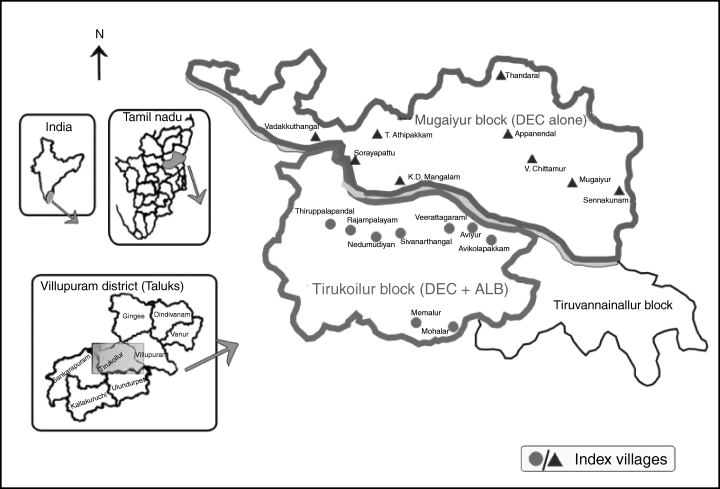
Map of study area.
Mass drug administration
Three MDAs were carried out with DEC alone between 1997 and 2000 in both the study blocks as part of the national programme under the ‘Revised Strategy for the Control of Lymphatic Filariasis’. After randomization in 2001, Mugaiyur block continued to receive DEC only (DEC alone arm), while the people in Tirukoilur block were co-administered with DEC + ALB (two-drug arm). Three more MDAs from 2001 (2001, 2002 and 2003) were carried out with this new protocol in the two study blocks. In each MDA, all the available inhabitants of the study area (except <2-year-old children and pregnant women) were targeted. The health system distributed the drugs and a door-to-door strategy was chosen as the method of drug administration. Drug coverage (the number of individuals who had received the drug among the total population) and compliance (the number of individuals who had consumed the drug among the total individuals) were estimated after each MDA. Our research team evaluated the study independent of the health system. The Ethics Committee of the Centre for Research in Medical Entomology (Indian Council of Medical Research), Madurai, India cleared this study, as per the national guidelines.
Filarial infection in community
Filarial infection status was assessed before the first MDA and 1 year after each MDA. In each survey, conventional thick smears by finger prick were used to collect 20 μl of blood between 21.00 and 24.00 h for determining the MFP status. At each time point (before and after each MDA), blood samples were collected in households selected at random. A neighbouring household with similar social attributes was sampled if a selected household was unavailable. The Mf counts were recorded for each individual. From the same individual, 100 μl of blood was also collected to test for antigenaemia using an ICT card test kit (NOW® ICT-BINAX from USA) (Rajendran et al. 2002a). At each of the four survey points, 450–650 subjects in the age group of 2–25 years were covered in each study arm.
Vector infection status
The entomological monitoring was carried out monthly in all the index villages by collecting adult filarial vector Culex quinquefasciatus resting indoors from 16 human dwellings between 09.00 and 11.00 h (morning) by spending 15 min in each dwelling. From these collections the entomological parameters like vector density, infection status and transmission indices were estimated. Vector infection rate was defined as the percentage of mosquitoes that were found to have Mf and/or other stages of filarial larvae (L1, L2 and L3) among the total vector mosquitoes dissected. The infectivity rate was defined as the percentage of mosquitoes with L3 stage larvae among the total dissected. The transmission intensity index (TII) was calculated (Krishna Rao et al. 1981) utilizing entomological data. Prior to MDA 2001, collections were made for 5-month period from November 2000 to March 2001. Subsequently, even though surveys were continued for a period of 1 year (April to March in subsequent year) after each MDA, the 5-month data corresponding to the pre-treatment period alone were used for analysis in this study.
Soil-transmitted helminth infection in school children
Cross-sectional school surveys were conducted prior to treatment and 1 year after the first, second and third MDA of this study, using a randomly selected sample (325–500 in each arm) of children aged 9–10 years (fourth and fifth standards) in both arms. Stool examination was performed using Kato–Katz cellophane thick smear method (Ash et al. 1994).
Health education prior to MDA
Each MDA programme was preceded by an IEC (Information, Education and Communication) campaign and key feature of Tamil Nadu state's MDA programme was the use of a strong social mobilization campaign developed with the technical support of WHO and known as Communication for Behavioral Impact (COMBI). Our research group also participated in these efforts and undertook intensive advocacy campaign with active support from the local Non-Governmental Organizations (NGOs).
Statistical analysis
The data were analyzed using the statistical package SPSS/PC+, version 11.5 and EPI INFO version 6.0. The prevalence rates were computed by calculating the percentage of subjects found positive for any infection at each survey. Geometric mean intensities (GMIs) of MFP were calculated as antilog [∑ log (x + 1)/n] − 1, with ‘x’ being the number of Mf/20 μl of blood and ‘n’ the number of individuals examined (includes both Mf positive and negative persons). The significance of changes in the prevalence after three MDAs was estimated by chi-squared analysis while the differences of the GMI after MDAs were determined by independent sample ‘t’ test. The antigenaemia and microfilaraemia prevalences during pre-treatment and after three MDAs were analysed for the 95% confidence interval. Linear regression analysis was made for the different data points before and after MDAs for the three parameters [MFP, Mf (GMI) and AGP]. Significant relative changes in the prevalences from baseline to the post-MDA time points in the two treatment arms were tested by applying an odds interactive test from a log-linear model by using the method of Khan and Sempos (1989).
Results
Baseline values prior to MDAs
All pre-treatment values collected prior to MDA 2001 between the two treatment arms were comparable (P > 0.05), for filarial as well as for overall STH infections.
Filarial infection in the community
During this period, the microfilaraemia (MFP) and antigenaemia (AGP) prevalence in 2–25 years age group were 5.21% and 18.87% in DEC + ALB arm while 4.34% and 15.19% in DEC alone arm respectively (2, 5). The Mf intensity in the two arms was 0.1484 and 0.0956. In the younger age group of 2–5 years, the prevalences were 0.62 and 0.52 for MFP and about 9% for AGP. The 10–25 years age group in DEC alone arm had significantly lower AGP.
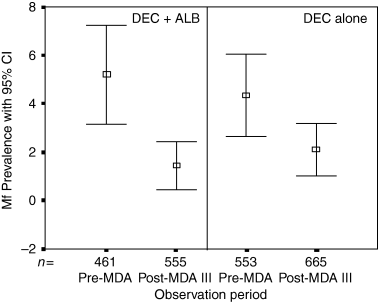
Microfilaraemia prevalence before and after three mass drug administrations in the two-treatment arms.
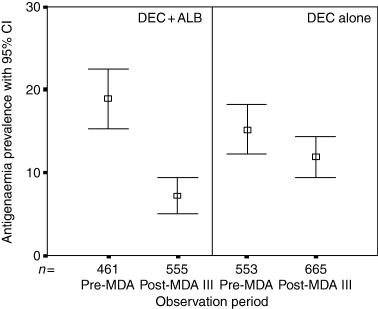
Antigenaemia prevalences before and after three mass drug administrations in the two treatment arms.
Vector infection
In both the treatment arms about 3000 vectors were dissected during the pre-treatment period. The vector infection rates were 5.5%–5.8% in DEC + ALB and DEC alone arms respectively. The TII values estimated from resting collection were 0.5329 and 0.4159, respectively, in DEC + ALB and DEC alone arms. These values were comparable between the two treatment arms.
STH infection in children
The infection caused by STH was recorded in about 60% of school children in the age group of 9 and 10 years during the pre-treatment period. The prevalence rates for individual helminths were 54.8%, 16.5% and 4.7% in the DEC + ALB arm while 52.9%, 8.3% and 6.8% in the DEC alone arm, for Ascaris lumbricoides, hookworms and Trichuris trichiura respectively.
Drug compliance during MDA
In MDAs carried out during 2001, 2002 and 2003, the drug compliance rates were 52%, 84% and 65% in the two-drug arm while in DEC alone arm the rates were 42%, 80% and 72% respectively (Table 1). The adverse drug reactions (ADRs) reported by the villagers were similar in both treatment arms and the combined ADRs were 8.8%, 3.0% and 2.1% during the 3 years respectively. The reactions were mild with giddiness and dizziness constituting 54% of the symptoms, followed by fever and headache. The local public health personnel successfully managed these reactions.
| Year of MDA | Treatment arm | Number sampled | Coverage (%)* | Compliance rate† |
|---|---|---|---|---|
| 2001 | DEC + ALB | 703 | 72.7 | 52.4 |
| DEC alone | 827 | 67.9 | 42.4 | |
| 2002 | DEC + ALB | 1400 | 94.4 | 83.6 |
| DEC alone | 1226 | 98.9 | 80.3 | |
| 2003 | DEC + ALB | 1724 | 78.8 | 65.1 |
| DEC alone | 1432 | 88.0 | 71.5 |
- DEC, diethylcarbamazine; ALB, albendazole.
- * Coverage represents the number of individuals who had received the drug among the total population.
- † Compliance represents the number of individuals who had consumed the drugs among the total population.
Impact of three MDAs on microfilaraemia
The prevalence of microfilaraemia (MFP) reduced significantly (P < 0.05) in both the treatment arms after three annual doses of MDA (Figure 2). The data points observed before and after each MDA were regressed in both treatment arms, and the R2 -value was slightly higher in the DEC + ALB arm than in the DEC alone arm (Figure 3). Similarly, the percentage reductions were higher in the DEC + ALB arm (72.4%vs. 51.4%) (Table 2). In children of 2–5 years, nil positivity was observed in the DEC + ALB arm after two MDAs while it was recorded after three MDAs in the DEC alone arm (Table 2). In the higher age group of 10–25 years, even though both treatment arms showed a reduction in MFP, significance was recorded only in the DEC + ALB arm (P = 0.0059).
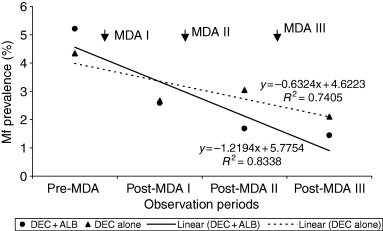
Relative change in microfilaraemia prevalence in the two-treatment arms after each mass drug administration.
| Age group (years) | Treatment period | DEC + ALB | DEC alone | ||||
|---|---|---|---|---|---|---|---|
| Number sampled | Prevalence (%) | GMI (Mf) | Number sampled | Prevalence (%) | GMI (Mf) | ||
| 2–5 | Pre-MDA (March 2001) | 161 | 0.62 | 0.0188 | 193 | 0.52 | 0.0072 |
| Post-MDA I (March 2002) | 163 | 0.61 | 0.0085 | 206 | 0.97 | 0.0141 | |
| Post-MDA II (March 2003) | 171 | 0.00 | 0.0000 | 214 | 0.47 | 0.0155 | |
| Post-MDA III (March 2004) | 194 | 0.00 | 0.0000 | 229 | 0.00 | 0.0000 | |
| 10–25 | Pre-MDA (March 2001) | 171 | 10.53 | 0.2910 | 215 | 8.37 | 0.1637 |
| Post-MDA I (March 2002) | 168 | 4.76 | 0.0935 | 194 | 6.19 | 0.0969 | |
| Post-MDA II (March 2003) | 164 | 4.88 | 0.0893 | 210 | 6.19 | 0.1370 | |
| Post-MDA III (March 2004) | 202 | 2.97* | 0.0533 | 263 | 4.94 | 0.0553 | |
| 2–25 | Pre-MDA (March 2001) | 461 | 5.21 | 0.1484 | 553 | 4.34 | 0.0956 |
| Post-MDA I (March 2002) | 465 | 2.58 | 0.0610 | 562 | 2.67 | 0.0423 | |
| Post-MDA II (March 2003) | 477 | 1.68 | 0.0298 | 590 | 3.05 | 0.0657 | |
| Post-MDA III (March 2004) | 555 | 1.44* | 0.0276* | 665 | 2.11* | 0.0492 | |
- DEC, diethylcarbamazine; ALB, albendazole.
- * Compared with the baseline values (March 2001), the post-MDA III values are significantly different (P < 0.05) by chi-squared analysis and Student's t-tests.
Linear regression analysis revealed a higher R2-value (0.8071) in the two-drug arm than the single drug arm (0.3970) (Figure 4). A marked and significant reduction in Mf intensity (81.4%; P < 0.001) was observed only in the two-drug arm (DEC + ALB) (Table 2), even though there was 48.5% (NS or P = 0.075) reduction in DEC alone arm.
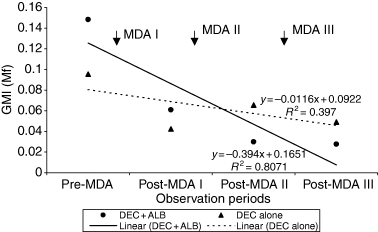
Relative changes in geometric mean intensity of microfilaraemia in the two treatment arms after each mass drug administration.
Impact of three MDAs on antigenaemia
The antigenaemia prevalence (AGP) was significantly reduced after three MDAs by 61.8% in the DEC + ALB arm (P < 0.001), compared with 21.8% in the DEC alone arm (P = 0.109) (Figure 5). A steep decline in AGP was noticed in the two-drug arm with each MDAs and the regression equation estimated was significant (R2 = 0.9917). In the DEC alone arm, the prevalence remained at 15% level till post-MDA 2002, which declined to 11% after MDA 2003 (Figure 6). The relative change (using odds ratio analysis) between the two treatment groups after three MDAs showed that combination therapy exerted a significant effect (Z = 3.08) to reduce the prevalence. In the younger age group of 2–5 years the reduction after three MDAs was more pronounced and significant in the combination therapy arm (72.3%; P = 0.012; Table 3) than in with the monotherapy arm (50.4%). In youth group of 10–25 years, the significant reduction (54.3%; P = 0.0003) was noticed only in the former (DEC + ALB), while it was still above baseline in the DEC alone arm.
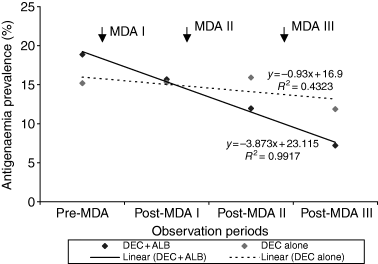
Relative changes in antigenaemia prevalence in the treatment arms after each mass drug administration.
| Age group (years) | Treatment period | DEC + ALB | DEC alone | ||
|---|---|---|---|---|---|
| Number sampled | Prevalence (%) | Number sampled | Prevalence (%) | ||
| 2–5 | Pre-MDA (March 2001) | 161 | 9.32 | 193 | 8.81 |
| Post-MDA I (March 2002) | 163 | 7.36 | 206 | 6.80 | |
| Post-MDA II (March 2003) | 171 | 6.43 | 214 | 7.48 | |
| Post-MDA III (March 2004) | 194 | 2.58* | 229 | 4.37 | |
| 10–25 | Pre-MDA (March 2001) | 171 | 29.24 | 215 | 19.07 |
| Post-MDA I (March 2002) | 168 | 24.40 | 194 | 25.77 | |
| Post-MDA II (March 2003) | 164 | 20.73 | 210 | 28.57 | |
| Post-MDA III (March 2004) | 202 | 13.37* | 263 | 21.67 | |
| 2–25 | Pre-MDA (March 2001) | 461 | 18.87 | 553 | 15.19 |
| Post-MDA I (March 2002) | 465 | 15.70 | 562 | 15.30 | |
| Post-MDA II (March 2003) | 477 | 11.95 | 590 | 15.93 | |
| Post-MDA III (March 2004) | 555 | 7.21* | 665 | 11.88 | |
- DEC, diethylcarbamazine; ALB, albendazole.
- * Compared with the baseline values (March 2001), the post-MDA III values are significantly different (P < 0.05) by chi-squared analysis and Student's t test.
Transmission parameters after MDAs
After MDA 2003, the PMH density did not change in either treatment strategy (23.3–25.7), but the transmission parameters declined in both. The infection and infectivity rates recorded a drop (by about 50%) in both the arms. The infectivity dropped from a pre-treatment value of 0.55% to 0.27% in the DEC + ALB arm against 0.66% to 0.28% in the DEC alone arm (Table 4). The TII values during post-MDA 2003 were 0.2001 and 0.1507 in DEC + ALB and DEC alone arms, respectively, demonstrating a reduction of 63% in both arms. The decline was significant only in the two-drug arm.
| Parameters | DEC + ALB | DEC alone | ||
|---|---|---|---|---|
| Pre-treatment | Post-MDA III | Pre-treatment | Post-MDA III | |
| Number collected (180 man hours) | 5311 | 4632 | 4173 | 4188 |
| Number dissected | 3433 | 3344 | 3177 | 3243 |
| PMH (F) | 29.51 | 25.73 | 23.18 | 23.27 |
| Parity rate (%) | 42.48 | 34.61 | 42.69 | 30.44 |
| Infection rate (%) | 5.53 | 2.18* | 5.76 | 2.16* |
| Infectivity rate (%) | 0.55 | 0.27 | 0.66 | 0.28* |
| Transmission intensity index (TII) | 0.5329 | 0.2001* | 0.4159 | 0.1507 |
- * Compared with the baseline values (March 2001), the post-MDA III values are significantly different (P < 0.05) by chi-squared analysis and Student's t test.
Co-administration of ALB with DEC against STH infection
Among the STHs, Ascaris was prevalent in 75% of the children while hookworm and Trichuris formed 17% and 8% of the infections. One year after MDA 2003, combination therapy (DEC + ALB) demonstrated a reduction in prevalence of 70.9% (60.4% reduced to 17.6%) for any of the three helminths while the egg reduction rate declined by 96.9% (36.5–1.2), higher than the corresponding reductions (6.5% and 48.7%) observed in the DEC alone arm (Figure 7). Reduction in prevalence and egg intensity was observed for all the three helminths in the DEC + ALB arm, and all were statistically significant (P < 0.001), except for Trichuris where the reduction was not significant. After three MDAs the DEC + ALB arm demonstrated prevalence reductions of 78%, 65% and 59% for Ascaris, hookworm and Trichuris, respectively, compared with the base values. In the DEC alone arm Ascaris alone demonstrated 23.8% reduction in prevalence after three MDAs, which was significant (P = 0.001). Infection with the other two helminths did not fall, rather an increase in both prevalence and intensity was observed after three MDAs.
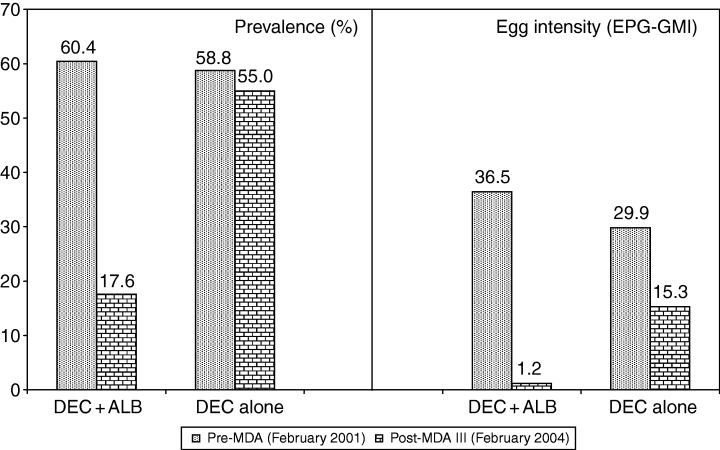
Reduction in soil-transmitted helminth infection after three mass drug administrations in school children aged 9 and 10 years.
Discussion
Considering the co-infection of lymphatic filariasis and STHs, a concurrent intervention against them using the same control method was suggested to be advantageous, efficient and cost-effective (Albonico et al. 1999, Beach et al. 1999, Molyneux & Zagaria 2002). The annual single dose MDAs are expected to interrupt transmission and prevent new infections, and the cumulative effect is expected to lead towards the elimination of LF (Ottesen 2000; Bockarie et al. 2002).
Countries such as Egypt, Samoa, Vanuatu, Tanzania and Zanzibar that have initiated LF elimination programmes (based on GPELF) are observing significant declines in prevalence and intensity of microfilaraemia of Wuchereria bancrofti after three or four rounds of MDA (Molyneux 2003). In our study also, there were marked reductions in MFP and GMI after three MDAs in both the treatment strategies, and the co-administration arm had a 1.5-fold advantage over the DEC alone arm for MFP reduction. Combination therapy (DEC + ALB) demonstrated a decrease in the GMI (Mf) to a greater extent than did DEC alone (Fox et al. 2005). During the second and third MDA, drug compliance reached 66.7% and 80%, probably because of intensive advocacy campaigns and other perceived benefits (Mani et al. 2002).
The two-drug arm achieved a three times higher reduction (61.8%vs. 21.8%) in the prevalence of antigenaemia than the single drug (DEC) arm, after three MDAs. The higher reduction in the antigenaemia could be due to the co-administration of ALB, which enhances the possible DEC-related effect on adult worms. The baseline values for our current report (18.8% and 15.2%) were from an area that had already received three MDAs with DEC alone (although at lower compliance rates), and the total MDAs delivered were six in all. In Papua New Guinea, antigenaemia declined by 37% (19%–12%), with two annual mass treatments using the DEC + ALB combination (Selve et al. 2000) while in the present study there was 62% reduction (18.9%–7.2%) after three annual rounds. In the age group of 10–25 years, there was only 54% reduction (in DEC alone arm an increase in prevalence was noticed with respect to the baseline value) when compared with 72% reduction in 2–5 years for antigenaemia in the two-drug arm. Apart from the postulated greater susceptibility of adult filarial worms in children to filaricidal drugs (DEC and ALB) (Rajendran et al. 2002a,b), the chances of new filarial infections in children dwindled because of steep declines in the microfilarial load in the human reservoir (both MFPs and intensities of parasite), as well as in vectors with infective stage parasites by about 50%, despite the unchanged relative densities of C. quinquefasciatus adult females (23.3–25.7 per man hour) in both arms of the study.
Absence of benefits in adult patients on antigenaemia clearance at 12 months with standard DEC 72 mg/kg dose was documented earlier (Day et al. 1991; Weil et al. 1988). We have discussed related studies along with our results on earlier MDAs and argued that more pronounced reduction of AGP in children might be due to the different location of W. bancrofti adult worms (Dreyer et al. 1999; Rajendran et al. 2002a,b), in addition to the low worm burden. However, Ramaiah et al. (2003) did not find any significant reduction in AGP in 1- to 5-year-old children even after six rounds of mass treatment with DEC.
In China the MFP was successfully brought down to <1.0% and the elimination of filarial infection in the age group of <10 years with multi-pronged approach in a short span of 6 years (Cao et al. 1997). The major programme in China involved the use of DEC medicated salt. But in our trials, with best efforts, only 67–80% of the target population swallowed the drugs and the childhood antigenaemia prevalence (CAP) remained at 2.6% in the two-drug arm, while the criterion for certification of elimination of filariasis from a region was set at 0.1% antigenaemia in children (World Health Organization 1999). GAELF hoped that human filariasis could be eliminated globally by 2020, if 80–90% of those living in at-risk communities were treated in annual MDAs for 5–6 years (Ottesen et al. 1999; WHO 1999). But developing countries like India may need few more rounds of MDAs (at least 10 rounds), before applying for certification of LF elimination. The data demonstrate that, to achieve LF elimination, the number of rounds of MDA could be reduced by the addition of ALB to DEC, if the drug coverage is at 70–80% and the reductions in infection levels are maintained.
In the study area covered, the additional benefit of DEC + ALB drug combination for STHs was recorded to be significant and sustained up to 11 months after MDA and related studies were reviewed along with our findings (Mani et al. 2002, 2004; Rajendran et al. 2003). In the present study, after three MDAs the DEC + ALB arm demonstrated prevalence reductions of 78%, 65% and 59% for Ascaris, hookworm and Trichuris respectively. In DEC alone arm Ascaris alone demonstrated significant reduction in prevalence after three MDAs, and no effect on the other two helminths (hookworm and Trichuris). Meyrowitsch and Simonsen (2001) also observed a similar effect of DEC on Ascaris and hookworm infection in children in Tanzania. Co-administration of ALB with DEC was reported to successfully reduce both the prevalence and intensity of intestinal helminths (Fox et al. 2005; Oqueka et al. 2005). There are only limited studies comparing the efficacy of two-drug combinations of DEC + ALB with other drugs for geohelminth control (Ismail & Jayakody 1999; Belizario et al. 2003; deSilva et al. 2003). At the post-MDA 2003 cross-sectional study, the STH prevalence reduction in DEC alone arm was found to be 10 times lower than that of two-drug arm. Also, the egg reduction rate in the DEC alone arm was only half that of the DEC + ALB arm.
We conclude that the drops in microfilaraemia and antigenaemia prevalences in the two-drug arm exceeded those of the DEC alone arm by a factor of of 1.5 and 3 respectively. Additionally, ‘beyond filariasis benefits’ rendered by ALB (2- to 10-fold advantage) in reducing STH infections and intensities were also evident. Thus, our study confirmed higher and sustained benefits with regard to filarial and STH infections for the two-drug arm over the DEC alone arm, even at 67–80% drug compliance rates. However, the trends suggest that at least 10 MDAs may be essential to reach and maintain criteria set for filariasis elimination.
Acknowledgements
The study was supported financially by WHO/TDR, Geneva (ID no. A00257). The facilities extended by ICMR are gratefully acknowledged. Authors are grateful to Dr R. Reuben, former Director of CRME, for her critical comments of the manuscript. The valuable suggestions made by Dr V. Kumaraswami, Deputy Director, Tuberculosis Research Centre, Chennai is gratefully acknowledged. The authors also wish to express their thanks to the staff of Department of Public Health and Preventive Medicine (DPH&PM), Tamil Nadu for their kind co-operation in conducting the field work. We acknowledge the laborious and painstaking works of the staff members of our field station at Tirukoilur. We appreciate the excellent help rendered by Shri A. Venkatesh, Research Assistant, CRME, Madurai, in preparation of this manuscript, particularly in DTP work.




